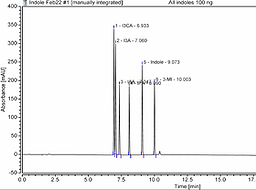

Research
The Lavado Lab is a research facility housed within the Baylor Sciences Building (Baylor University) in Waco, Texas. Our multidisciplinary team specializes in conducting original research in environmental and molecular toxicology.
An overarching focus in projects conducted in our lab is answering questions related to human and environmental health effects. This includes questions about possible exposures to environmental contaminants and cellular mechanisms of toxic action after exposure.
We aim to conduct cutting-edge research in the following areas:
-
Aquatic Toxicology.
-
Environmental Health Sciences.
-
Exposure and Risk Assessment.





Alternative Approaches to Animal Toxicity Testing - Cell-based Models
Toxicity tests are often based on in vivo assays, and although the results from these whole organism assays can be effectively extrapolated to the natural environment, the use of animals has been debated for ethical reasons, as well as for animal welfare issues. Initiatives such as the “3 Rs”, standing for Refinement, Reduction and Replacement, have been implemented to find suitable alternatives to the use of animals, increasing the need for appropriate in vitro systems for toxicity testing. One such alternative to in vivo studies is the use of cell cultures. Cell lines have become a cost-efficient and effective in vitro tool in aquatic toxicology as they allow for the determination of the interference with biological processes by contaminant exposure.
Our lab focuses on research on the use of cell lines in ecotoxicology. Their use has been increasing in recent years, and while several publications have reported valuable data using in vitro models. Thus, it is fundamental to continue the search for more suitable cell lines as models to select appropriate alternatives to address specific environmental issues and for effective ecological risk assessments.




Biotransformation of Pollutants: Pathways, Impacts, and Environmental Solutions
Biotransformation studies in environmental science are relevant due to their pivotal role in understanding and managing environmental pollution:
-
Detoxification of Xenobiotics: Biotransformation processes in the liver and other tissues help convert foreign and potentially harmful substances, known as xenobiotics, into more water-soluble and less toxic forms. This detoxification process protects the body from the harmful effects of drugs, environmental pollutants, and dietary toxins.
-
Drug Metabolism: Biotransformation is central to the metabolism of pharmaceutical drugs. It determines how drugs are absorbed, distributed, metabolized, and excreted from the body. Understanding drug metabolism is essential for optimizing drug dosages, minimizing adverse reactions, and ensuring the efficacy of medications.
-
Toxin Elimination: Biotransformation helps eliminate endogenous waste products and toxins, including metabolic waste and excess hormones. Dysfunction in these processes can lead to the accumulation of harmful substances in the body, potentially contributing to diseases.
-
Metabolism of Environmental Toxics: Biotransformation enzymes also play a role in metabolizing environmental toxics and pollutants that can be absorbed through air, water, and food. Effective biotransformation helps minimize the accumulation of these toxins in the body, reducing the risk of toxin-related diseases.
Our laboratory is dedicated to advancing the field of environmental science and human health by conducting cutting-edge research on the biotransformation of contaminants. Through rigorous experimentation and innovative techniques, we aim to unravel the intricate mechanisms through which animals transform pollutants, ultimately contributing to the development of sustainable solutions for pollution mitigation and safeguarding human and environmental well-being.





Identification of Endocrine-Disrupting Chemicals in the Environment
Increasing urbanization leads to more human consumption, including many consumer products (e.g. pharmaceuticals and personal care products) directly related to environmental contaminants of emerging concern (CECs). These contaminants have been a matter of intensive research, and several studies have identified the presence of CECs in surface waters. Unfortunately, most wastewater treatment plants are not equipped with the technology to effectively remove CECs, of which pharmaceuticals, personal care products, and endocrine-disrupting compounds (EDCs) can present important risks to water quality.
Fish populations in urban surface waters are commonly at risk from EDCs. Acute responses from exposure to EDCs are relatively uncommon; however, chronic effects are highly prominent in EDC-contaminated waters, especially for early life stages. These effects range from induction of the protein vitellogenin, reduced gonad size, and disruption of ovarian and testicular morphology and histopathology, to more severe effects such as complete alteration of sex ratios and feminization of male fish.
Our laboratory uses a combination of analytical chemistry, biomarkers of exposure, and field- and laboratory-based bioassays to provide multiple lines of evidence for evaluations of the estrogenic potential of effluent-dominated surface waters. This contributes to the development of advanced strategies for water and wastewater management in urban areas.